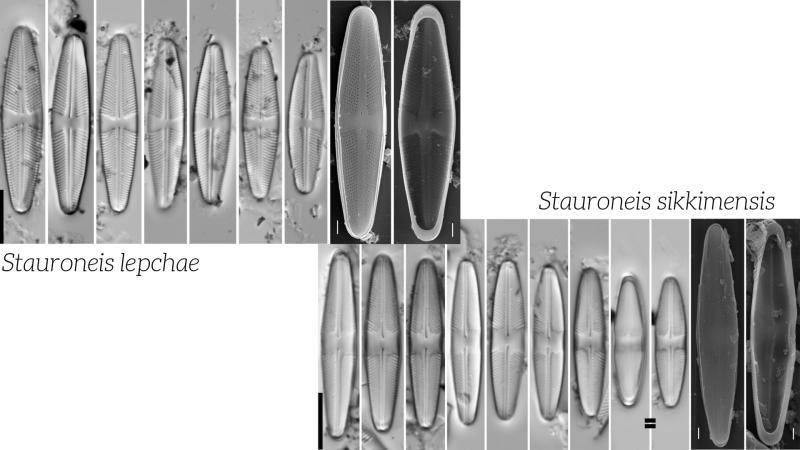
What do you get when a trip to Sikkim does not follow the plan, thanks to hectic schedule and unfavourable weather? It's a frustration for many; a "Eureka!" moment for some! The latter is what happened when Dr Balasubramanian Karthick and his team of researchers went to Sikkim last year. A trip, meant to meet up with fellow scientists, ended with the discovery of two new species of diatoms!
“On our way back, some of us saw a massive rock on the roadside covered with moss. Out of curiosity, we scrubbed some of it and brought them to our lab”, describes Dr Karthick, a researcher at the Agharkar Research Institute, Pune. Observing these samples under a microscope revealed two new species of diatoms—Stauroneis sikkimensis and Stauroneis lepchae—the first-ever diatom species reported from Sikkim. The study on these findings, published in the journal Botany Letters, was funded by the Department of Biotechnology, and included collaborators from the University of Colorado, USA.
Diatoms are single-celled microscopic algae known for their peculiar cell wall made of silica, which shows a wide diversity in form and shapes. They grow in moist regions and are commonly found in rivers, wetlands, ocean and soil, and are a source of food for many organisms. They also act as indicators of the environment, giving clues about the quality of the water in which they thrive.
"Diatoms are responsible for about 25% of the global oxygen production. So, every fourth breath we take in, the oxygen in it comes from diatoms", says Neha Wadmare, PhD student at Agharkar Research Institute and Savitribai Phule Pune University. "However, we have not yet explored the rich diversity of these diatoms. We know only about 20-30 thousand species of these organisms, which is estimated to be over a million", she adds.
The two new species belong to the genus of diatoms called Stauroneis, which are found in semi-aquatic habitats, areas covered with moss or on tree barks. Out of the 1200+ species of diatoms belonging to this genus in the world, about 120 are found in the Indian subcontinent. Stauroneis sikkimensis is named after the state of Sikkim, where it was first discovered. The other species, Stauroneis lepchae, takes its name from Lepcha, the earliest ethnic group in Sikkim.
The cell of a diatom is like a soapbox—it has a larger, upper valve akin to the lid, and a smaller, lower valve like the base. Diatoms of the genus Stauroneis have a unique structure called stauros in the central area of their valves, which are marked by the thickening of silica. In S. sikkimensis, the stauros look like the letter "H', whereas in S. lepchae, they resemble a bow-tie. The valves of both the species are elongated; wider in the middle and tapering at both ends. Additionally, S. sikkimensis has a constriction in the centre of the valve.
The discovery of the two species is not the first from the northeast, and last year, Dr Karthick's team had discovered three new species from Arunachal Pradesh. Their efforts are a part of the larger project called 'Bioresource and sustainable livelihoods of North East India', sponsored by the Department of Biotechnology. This initiative aims to document the rich biodiversity of the region, where there have been recent discoveries of new species of frogs, geckos and snakes.
“Documenting every species is important, but conservation and documentation efforts are currently concentrated in protected areas and on specific organisms like some large mammals or orchids”, says Dr R Ganesan from the Ashoka Trust for Research in Ecology and the Environment (ATREE), Bengaluru, who is also the coordinator of the DBT initiative. He stresses the need for exploring the diversity in otherwise-neglected organisms, including microbes, as many of them have industrial applications too. This initiative, he says, will create resource-persons from the northeastern states who can document and conserve biodiversity in the future.
Dr Karthick and his team hope that explorations in the northeastern states could lead to describing many more new species of diatoms and other organisms. "We have spent some time in Mizoram and Meghalaya and noticed many new species of diatoms, or even probable genus, and we are in the process of describing them", concludes Dr Karthick.
This article was published with support from the India Science Media Fellowship 2019 by the Wellcome Trust/DBT India Alliance and Nature India.
This article has been run past the researchers, whose work is covered, to ensure accuracy.





